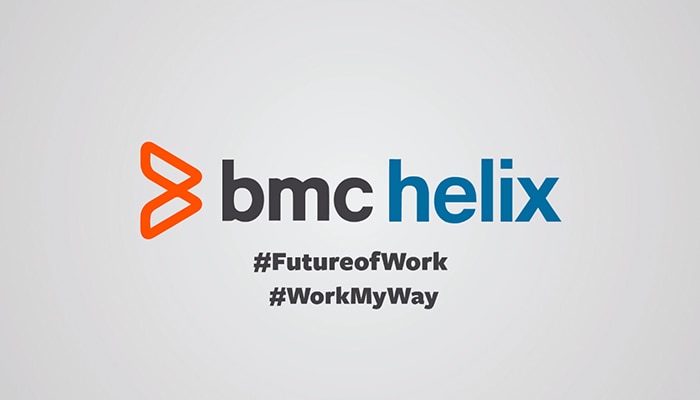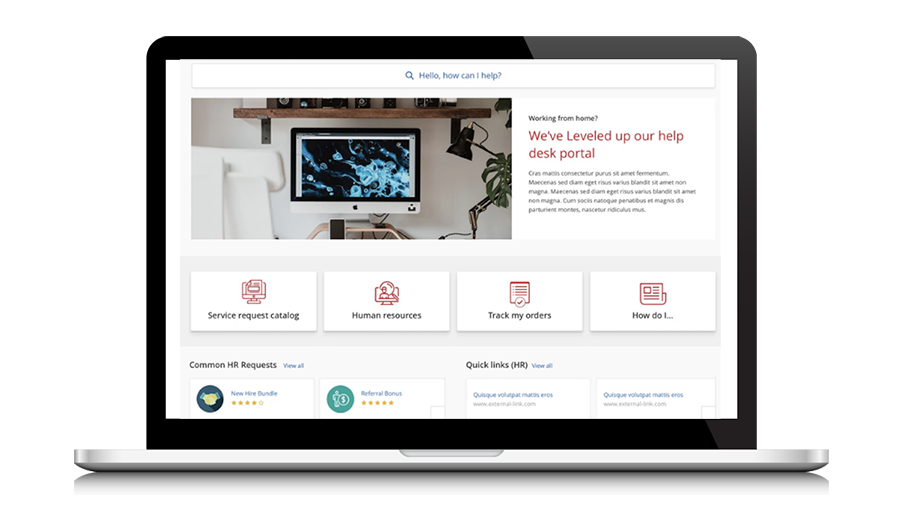Let us know how we can help
Sales & Pricing
Speak to a rep about your business needs
Help & Support
See our product support options
General inquiries and locations
Contact usBMC Helix Employee Experience solutions are designed for your company’s most valuable asset, your people. Empower your employees with the user experiences and information they need for success and increased job satisfaction- regardless of location.

Delight your employees with the resources they need and when they need it
Your employees sit at the center of meeting service expectations for all users – whether within your organization, external customers, or ecosystem partners. The Digital Employee Experience (DEX) encompasses every aspect of your employee's interaction with enterprise service management technology. It can include quality, ease of use, availability, security, and reliability. But it also encompasses inclusivity, accessibility, and other aspects of the end-user experience. BMC Helix Employee Experience solutions enable success, at every phase of the employee journey, by delivering the following benefits:
-
Simplifies collaboration and communication across Lines of Business
-
Automates redundant and manual processes to eliminate time-consuming workflows
-
Keeps your employees connected with ease of multichannel access on employee devices of choice
-
Ensures business continuity by resolving incidents faster, so your teams can get back to work with minimal disruption
-
Empowers employees to get the answers they seek, in real-time, through the convenience of self-service and knowledge resources

Explore available BMC Helix Employee Experience solutions and their impact
BMC Helix Employee Experience solutions are the foundation for automated, intelligent multichannel engagement. Even better, all of our BMC Helix solutions are pre-integrated and interoperable, saving your employees and Lines of Business valuable time. BMC Helix Employee Experience solutions span:
-
BMC Helix Digital Workplace Advanced is a single source, ‘drag and drop configurable’ solution to program everything your enterprise needs to build a unified service catalog, accessible on any device with single sign-on (SSO) and activate employee self-service.
-
BMC Helix Digital Workplace Studio offers ‘No Code’ authoring and publishing microsites designed to provide content, information, tools, and services tailored to the needs of a hybrid work environment – whether from an organizational, team or individual point of view.

-
BMC Helix Virtual Agent is an AI-driven, conversational chatbot integrating automated metadata and Natural Language Processing (NLP). It drives fast, efficient case resolution across your channels of choice – including Slack™, SMS, MS Teams™, WhatsApp™, Progressive Web Applications, and more.
-
BMC Helix Knowledge Management by ComAround can reduce cases by up to 50% through self-help knowledge repositories while empowering agents to resolve cases and incidents with real-time access to best practices data.
-
BMC Helix ITSM for ChatOps delivers proactive chat notifications and alerts across users. In addition, teams can collaborate directly on chat for knowledge swarming. Alerts can be programmed based on individual user profiles with embedded prompts for further action, such as auto-assignments and creating task subgroups.
Trends Driving the Digital Workplace
Intelligent automation: To help reduce error rates, eliminate time spent on tasks that can be automated as well as help solve issues either through self-help or knowledge search, saving higher skilled resources for more complicated tasks.
Multichannel engagement of choice: Using channels configured with value-added experiences and knowledge management capabilities, employees can find the information they need, when they need it.
Personalized employee experiences: Concierge-level, proactive automation services will help increase productivity and relieve the time burden on employees.
Continuation of hybrid workforce: Employees are no longer bound by traditional enterprise structures, and this multi-generational workforce has varying needs for collaboration and communication. With BMC Helix Employee Experiences solutions, your business can offer intelligent, multichannel, personalized experiences while preserving business continuity for the hybrid workforce.
Expectations of Today's Workforce
Replace a sprawling service catalog with a unified, seamless service experience across devices, locations, and modes of communication.
Responsive: So that people can work on any device, anywhere without compromise.
Intelligent self-service: Employees want proactive engagement with digital assistants that understand natural language, make helpful suggestions and know who they are.
Simplified service catalog: So that employees can take care of their own needs, arrange support on their own schedule, and stay productive.
Consumer-like experiences: To engage employees with a consumer-like experience that is intelligent, conversational, and personalized.
Solutions for Your Digital Workplace
BMC Helix Digital Workplace
BMC Helix Digital Workplace delivers one-click self-service to the products and services employees need to do their work.
BMC Helix Virtual Agent
Use generative AI chat and knowledge solutions to bring intelligent self-service to life.
BMC Helix ITSM
Predictive IT service management for your modern enterprise
BMC Helix Business Workflows
BMC Helix Business Workflows lets you define and automate workflows, and manage cases across every line of business with ease and efficiency.
Additional Resources
Analyst Research
The Changing Enterprise Service Management Market with BMC Helix ITSM and BMC Helix DWP TEI Results
Forrester’s research finds that a majority of enterprises — 54% — plan to increase mainframe usage over the next two years.